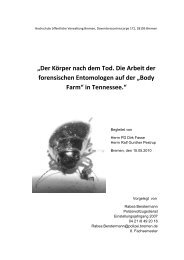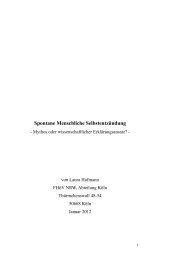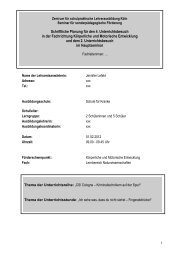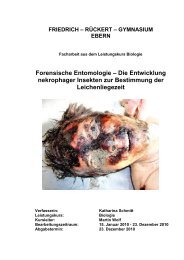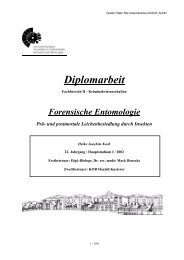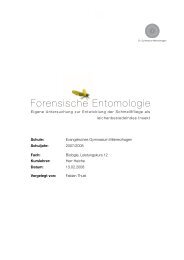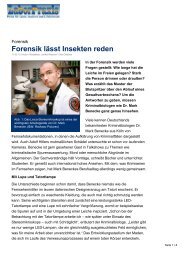A brief survey of the history of forensic entomology - Wiki2.benecke ...
A brief survey of the history of forensic entomology - Wiki2.benecke ...
A brief survey of the history of forensic entomology - Wiki2.benecke ...
You also want an ePaper? Increase the reach of your titles
YUMPU automatically turns print PDFs into web optimized ePapers that Google loves.
22 MARK BENECKE<br />
worked toge<strong>the</strong>r with ano<strong>the</strong>r person.<br />
In his paper, BERGERET (1855) gives a <strong>brief</strong><br />
overview on <strong>the</strong> life cycle <strong>of</strong> insects in general.<br />
He mistakenly assumes, however, that<br />
metamorphosis would generally require a full<br />
year. Fur<strong>the</strong>rmore, he assumes that females<br />
generally lay eggs in summer and that <strong>the</strong><br />
larvae would transform to pupae (he calls<br />
<strong>the</strong>m nymphs) <strong>the</strong> following spring and hatch<br />
in summer. Some details <strong>of</strong> BERGERET’s calculation:<br />
“The eggs <strong>of</strong> <strong>the</strong> larvae we found on <strong>the</strong><br />
corpse in March 1850 must have been deposited<br />
<strong>the</strong>re in <strong>the</strong> middle <strong>of</strong> 1849. Therefore,<br />
<strong>the</strong> corpse must have been deposited<br />
before this time interval. Next to <strong>the</strong> many<br />
living larvae <strong>the</strong>re were numerous pupae present,<br />
and <strong>the</strong>y must come from eggs that have<br />
been laid earlier, i.e., in 1848. (...) Could it be<br />
that <strong>the</strong> corpse was deposited even before<br />
that time [i.e., 1848]? The fly that emerges<br />
from <strong>the</strong> pupae that we found in <strong>the</strong> body<br />
cavities, is Musca carnaria L. that lays its eggs<br />
before <strong>the</strong> body dries out. We found o<strong>the</strong>r<br />
pupae <strong>of</strong> little butterflies <strong>of</strong> <strong>the</strong> night [moth],<br />
too, that attack bodies that are already dried<br />
out. If <strong>the</strong> body was deposited, say, in 1846<br />
or 1847, we would not have found those larvae<br />
[since <strong>the</strong>y would have hatched]. In conclusion,<br />
two generations <strong>of</strong> insects were<br />
found on <strong>the</strong> corpse, representing two years<br />
postmortem: on <strong>the</strong> fresh corpse, <strong>the</strong> flesh<br />
fly deposited its eggs in 1848, on <strong>the</strong> dried<br />
out corpse, <strong>the</strong> moth laid <strong>the</strong>ir eggs in 1849.”<br />
In retrospect, one should understand that<br />
BERGERET did not focus on <strong>forensic</strong> <strong>entomology</strong><br />
in his report but used <strong>the</strong> method as<br />
one <strong>forensic</strong> tool among o<strong>the</strong>rs. Indeed, <strong>the</strong><br />
mummification <strong>of</strong> <strong>the</strong> cadaver appears to be<br />
his overriding issue <strong>of</strong> interest in this case.<br />
BERGERET references ORFILA & LESUEUR (1831,<br />
1835) in <strong>the</strong> matters <strong>of</strong> both mummification<br />
and <strong>forensic</strong> <strong>entomology</strong>. He also clearly<br />
notes <strong>the</strong> lack <strong>of</strong> knowledge concerning insect<br />
succession on corpses in his day.<br />
In 1879, <strong>the</strong> president <strong>of</strong> <strong>the</strong> French Society<br />
<strong>of</strong> Forensic Medicine, BROUARDEL reported<br />
ano<strong>the</strong>r early case. P.C.H. BROUARDEL, born in<br />
Saint-Quentin on 13 February 1837, became<br />
a member <strong>of</strong> <strong>the</strong> French Academy <strong>of</strong> Medicine<br />
in 1880. He worked on tuberculosis, vaccination<br />
and legal medicine. His numerous<br />
medico-legal accounts include practical guidelines<br />
for his colleagues in <strong>the</strong> morgue. A contemporary<br />
said that “his work is conscientious,<br />
clear, methodic, and serves as a model”<br />
(quote from encyclopedia <strong>of</strong> that time;<br />
retrieved in 1998 by MB in Manhattan (New<br />
York University (NYU) Hospital Library);<br />
exact title and year unknown.)<br />
In his report, after referencing <strong>the</strong> work <strong>of</strong><br />
BERGERET (l.c.), BROUARDEL (1879) describes<br />
<strong>the</strong> case <strong>of</strong> a newborn child that was autopsied<br />
by him on January 15, 1878. The mummified<br />
body was inhabited by several arthropods,<br />
including butterfly larvae and mites,<br />
which led to a request for assistance from<br />
Monsieur PERIER, pr<strong>of</strong>essor at <strong>the</strong> Museum<br />
<strong>of</strong> Natural History in Paris, and army veterinarian<br />
J.P. MÉGNIN. PERIER reported that <strong>the</strong><br />
body was most likely dried out before it was<br />
abandoned. The determination <strong>of</strong> mites was<br />
left to MÉGNIN whereas PERIER determined<br />
<strong>the</strong> butterfly larvae as “chenilles d’aglosses”,<br />
i.e., larvae from <strong>the</strong> genus Aglossa (small<br />
moth, family Pyralidae). From <strong>the</strong> state <strong>of</strong><br />
preservation and from <strong>the</strong> larvae found,<br />
PERIER stated that <strong>the</strong> baby may have been<br />
born and died <strong>the</strong> summer before (“de l’été<br />
dernier probablement”), i.e., around six to<br />
seven month before <strong>the</strong> corpse was autopsied.<br />
MÉGNIN (1894) reported that <strong>the</strong> whole<br />
body was covered with a brownish layer composed<br />
exclusively <strong>of</strong> mite skins and mite<br />
feces, but not living mites. Inside <strong>the</strong> cranium<br />
he found large numbers <strong>of</strong> a single mite<br />
species. Initially, a few larval mites must have<br />
been carried to <strong>the</strong> corpse by o<strong>the</strong>r arthropods.<br />
MÉGNIN (1894) calculated that on <strong>the</strong><br />
whole body 2.4 million dead or living mites<br />
were present. He also calculated that after 15<br />
days <strong>the</strong> first generation with 10 females and<br />
5 males had developed; after 30 days, 100 fe-



